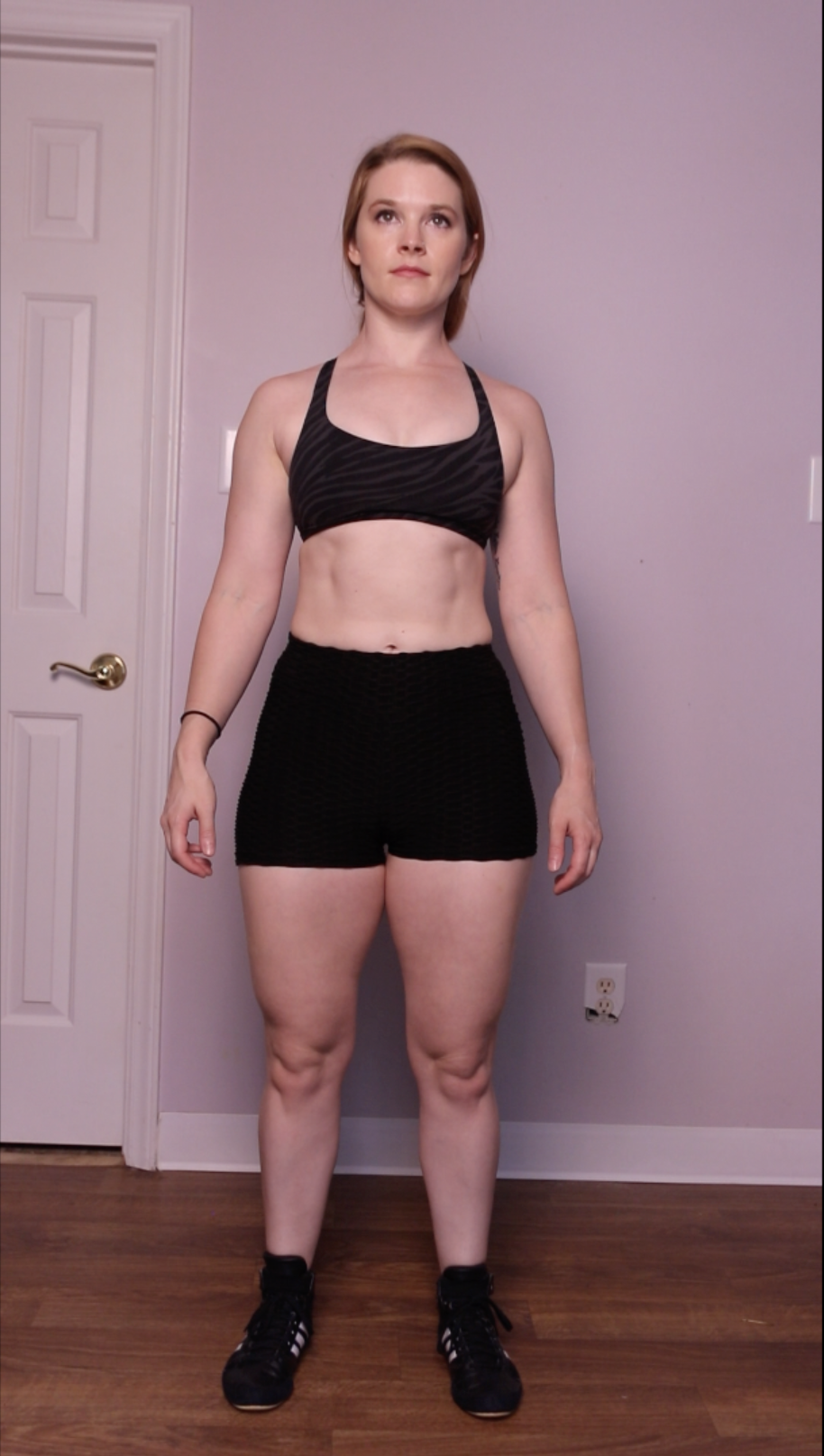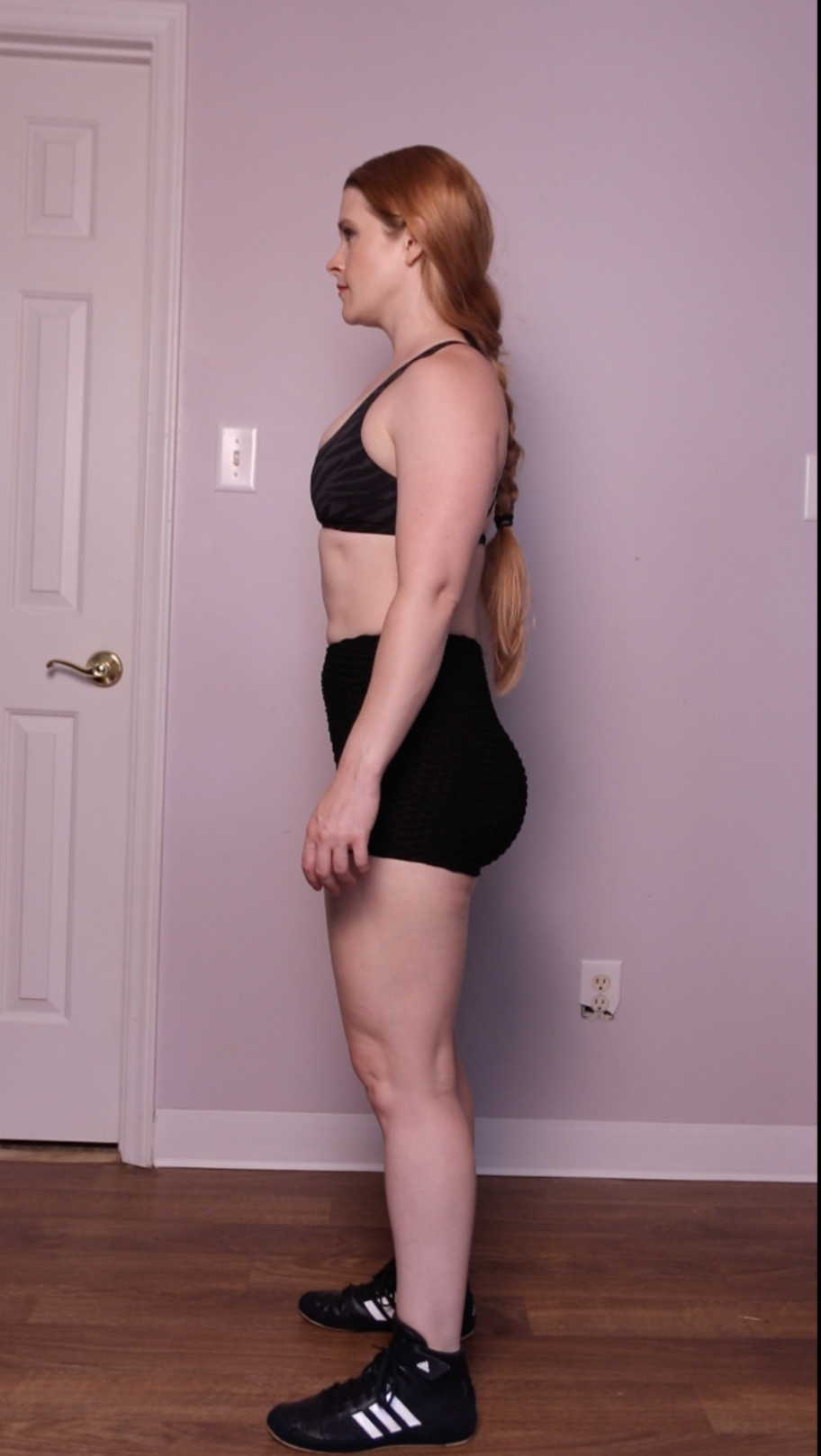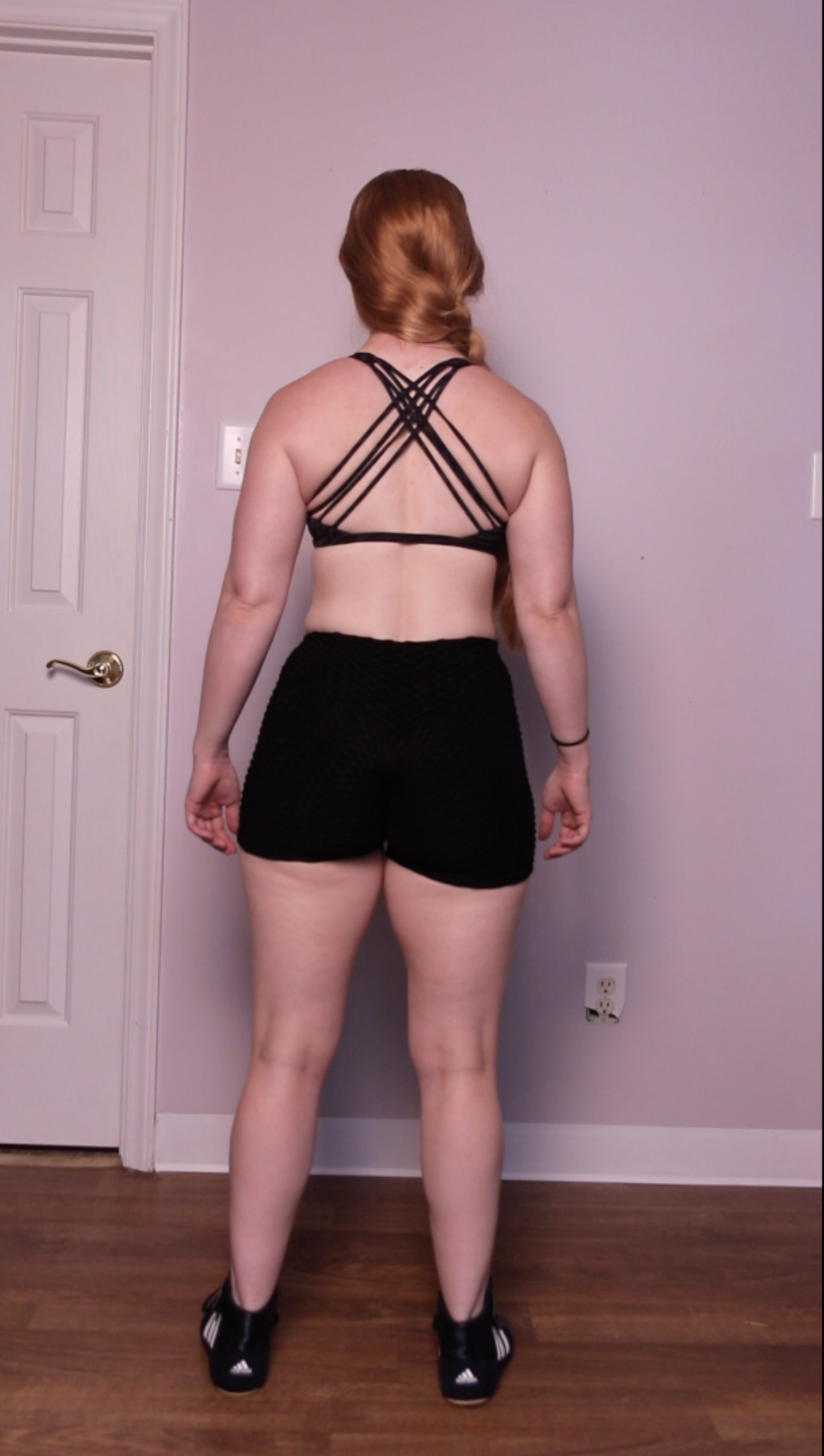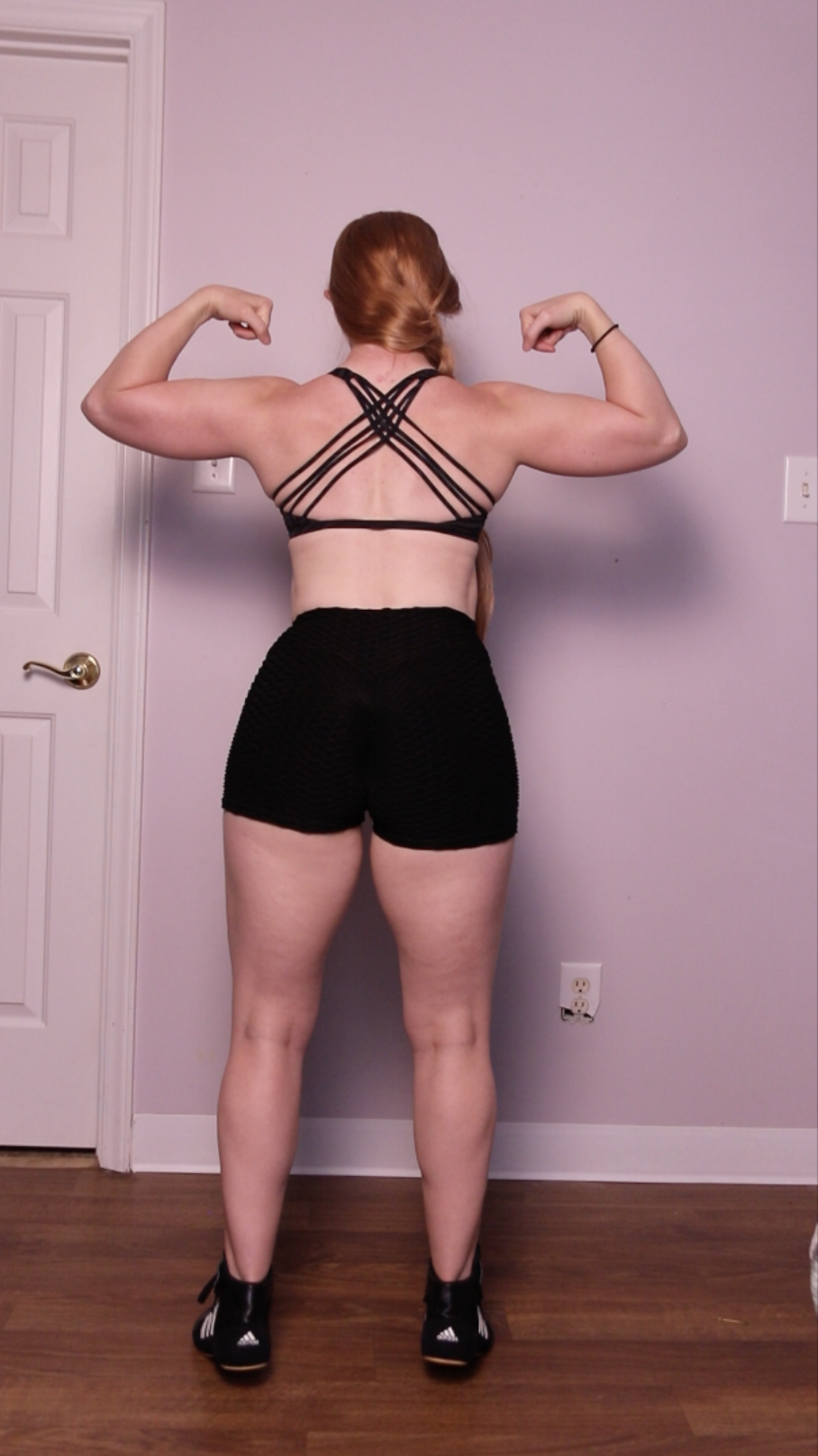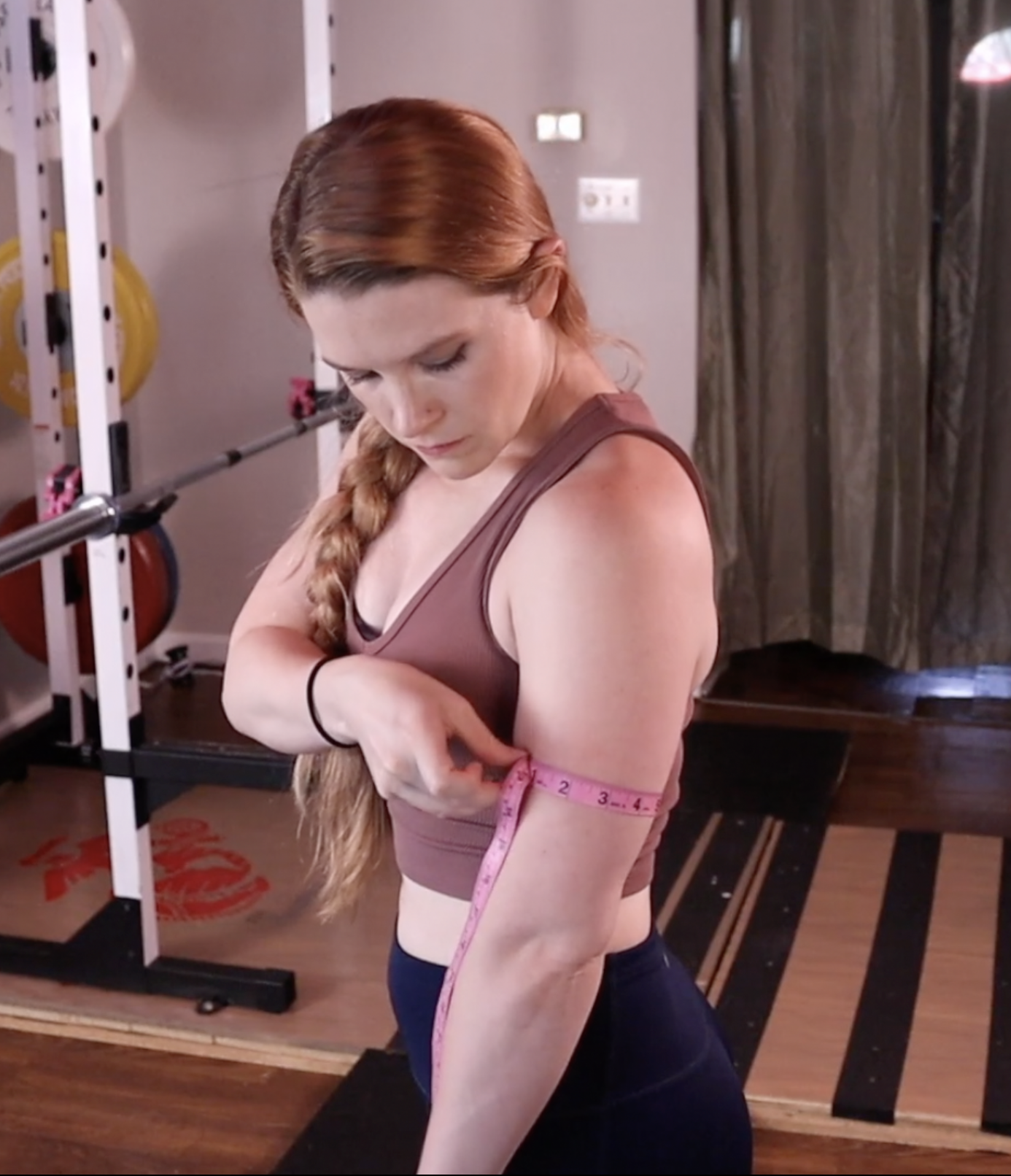How to Track Your Progress
One of the best ways to stay motivated in your fitness journey is to track your progress! Taking body measurements and progress photos every few weeks can give you a sense of momentum to keep showing up for your workouts and diet plan. It can also help you to avoid hitting a plateau.
There are 5 main strategies that I recommend to track your fitness progress:
Track Your Workouts
Take Progress Photos
Track Your Body Weight
Take Body Measurements
Measure Your Resting Heart Rate
Let’s take a look at each strategy in more detail in the sections below.
1. Track Your Workouts
A great way to see if your program is working is to track your workouts. This involves writing down what exercises you do, how many sets & reps you perform, and how much weight you use. Doing this creates a record of your progression over time.
If you’re one of my clients or subscribers, you can track your workouts in the Trainerize app or in your program spreadsheet. If you’re doing your own program, you can make your own spreadsheet or record your workouts in a journal or fitness app.
Each day that you train, record how much resistance you use for each exercise, as well as how many sets and reps you perform. It’s also a good idea to keep track of how difficult each set is. I encourage my clients to rate the difficulty of their sets in a Rate of Perceived Exertion (RPE) between 1 and 10:
RPE 1-4: Light resistance that can be used for mobility, recovery, and form emphasis.
RPE 5: Warmup Resistance Level (5 Reps in Reserve)
RPE 6: 4 Reps in reserve. Resistance level that one can move quickly for speed work (+/- 8 reps pending on speed/training goal).
RPE 7: 3 Reps In Reserve. Able to move quickly, form stays solid, and you could definitely get 3 more reps.⠀
RPE 8: 2 reps in Reserve. Resistance level is challenging but isn’t so heavy that you couldn’t do at least 2 more reps.
RPE 9: 1 rep in reserve. Tough but could squeeze out one more rep if you needed to.⠀
RPE 10: 0 reps in reserve. Max effort, couldn’t do another rep if your life depended on it.
For muscle building, you should generally keep your effort to an RPE 6, 7, or 8. As you get stronger and build more muscle, you’ll need to add on more repetitions, more sets, or more resistance to keep the exercises challenging. This is called “progressive overload.” Being able to do more reps, sets, or weight over time is a good sign that your program is working!
Keep in mind, however, that if you are in a caloric deficit and focusing on fat loss, it will take much longer for you to add more reps, sets, or resistance to your exercises. You may even see your strength and work capacity decrease, depending on how deep your cut is. That’s because your body is in a catabolic state focused more on breaking tissue down rather than building new tissue (as opposed to being in an anabolic state, focused on building tissue). This is totally normal, and most people see their strength come back rapidly once they end their cuts and enter into a maintenance or bulk phase.
2. Take Progress Photos
Another excellent way to track your progress is to taking progress photos every week or every few weeks. This creates a visual record of all the small, easy-to-miss changes that happen in your body throughout your program.
When you take your photos, try to keep the lighting and camera angle the same each time. It's also best to wear minimal clothing (like shorts and a sports bra). You can get someone to take progress photos for you or you can take them yourself by standing in front of a mirror.
For best results, take photos standing tall with your whole body in the frame. Make sure to take several photos: one facing forward, another showing your side profile, and another showing your back to the camera.
To track your muscle definition over time, you can also take several shots flexing in different poses:
I recommend taking progress photos at the beginning and end of each block of training, if not every week.
3. Track Your Body Weight
Another way to track your progress is to take your body weight either every day, every week, or once every few weeks. For fat loss, we generally look for body weight to decrease over time. For building muscle, we generally want to see body weight go up slowly over the course of a few weeks or months.
To get the most accurate data possible, do your weigh-ins at the same time each day (like in the morning, before breakfast). Also, wear minimal clothing and make sure to write down your weight in a fitness journal or track it in your fitness app.
Keep in mind that body weight isn’t always a straightforward indicator of progress. There are many things that can affect your weight on a day-to-day basis beyond fat loss and muscle gains. Water weight, your hormonal cycle, and even the food that you eat throughout the day can all cause your weight to fluctuate rapidly from one day to another or even from hour to hour.
It’s not uncommon to see body weight go up after a “treat meal” or after a few days on a diet break—especially if you eat a lot of carbohydrate-packed or sodium-dense foods. These things cause your body will retain more water, which can make you heavier. Your body will release that extra water weight when you exercise again. You can also flush it out by drinking lots of water and staying hydrated!
Also keep in mind that if you are in the process of what we call a “recomp” (i.e., you’re burning fat and building muscle at the same time), your body weight may not change much from week to week—even if you are making progress. That’s because in general, losing fat causes your body weight to decrease, while building muscle causes your weight to go up. When you do both at the same time, your body weight might stay the same or even increase, even though your clothes may be fitting looser and you may look leaner. In this case, you may want to rely more on progress photos and other body measurements (more on that below) to get a sense of your progress over time.
4. Take Body Measurements
Taking body measurements is one of the most effective ways to track your progress in both fat loss and muscle gains. For the most accurate measurements, use a telescope tape measure* (made specifically for taking body measurements). You can also use a flexible, inelastic tape measure or a cloth measuring tape.
Take your measurements at least twice to ensure accuracy (taking the average between the numbers).
Your waist and hip measurements are the most important for indicating progress in your fat loss and overall wellness. Start by measuring the circumference of your belly around your waist by wrapping the measuring tape around your torso at the level of your belly button. Make sure that it's straight and that you’re not holding it too tight, and avoid holding your breath. Record the inches or centimeters for your waist in your fitness journal or tracking app.
Next, wrap the measuring tape around the widest part of your hips and record the number of inches as your hips circumference.
To stay healthy, you’ll want to maintain a waist-to-hip ratio of below .95 (for men) or .90 (for women). To find your waist-to-hip ratio, divide your waist measurement by your hip measurement.[1, 2, 3]
If you are trying to build muscle, take measurements of the major muscle groups in your arms and legs, taking all measurements from the same side of your body (left or right):
Biceps: Wrap the measuring tape around the midpoint between the shoulder bone and the elbow of one arm.
Forearms: Wrap the measuring tape around the widest part of your lower arm just below the elbow.
Chest: Stand tall and wrap the measuring tape around the widest part of your chest.
Thigh: Wrap the measuring tape around your thigh at the midpoint between the lower part of the glutes and the back of the knee (or use the widest part of the thigh).
Calves: Measure the circumference of your calves at the halfway point between the knee and the ankle (or at the widest part of your calves).
Another important body measurements is body fat percentage. To stay healthy, it’s best to keep your body fat within a certain range of percentages:
Men:
Ages 20-29: between 8% and 18.6%
Ages 30-39: between 8% and 21.3%
Ages 40-49: between 8% and 23.4%
Ages 50-59: between 8% and 24.6%
Over 60: between 8% and 25.2%
Women:
Ages 20-29: between 14% and 22.7%
Ages 30-39: between 14% and 24.6%
Ages 40-49: between 14% and 27.6%
Ages 50-59: between 14% and 30.4%
Over 60: between 14% and 31.3%[4]
You can use a smart scale, handheld device, or skin calipers to measure your body fat percentage.
Keep in mind that all methods of measuring body fat percentage have varying levels of accuracy. Smart scales and handheld devices usually use bioelectrical impedance analysis—which measures your body composition based on the rate at which an electrical current travels through your body. Factors like your hydration and sodium levels as well as your hormonal cycle can affect the result number. So always take these measurements with a grain of salt, looking for general trends over time rather than focusing on the day-to-day number.
5. Resting Heart Rate
Another helpful way to track your progress over time is to take note of your resting heart rate. This is the number of times your heart beats per minute while you’re at rest. Normal resting heart rates are between 60 and 100 BPM. In general, we want to see this number decrease over time, indicating that your heart is getting more efficient.
It’s best to take your resting heart rate in the morning before you get out of bed. Find your pulse with your index and middle finger either on your wrist or the side of your throat. Set a timer for 1 minute and count the number of times you feel your heartbeat within that time. Record this number in your fitness journal or tracking app periodically to see how your heart health improves over time.
Get Tracking!
You can use any or all of the methods above to track your progress as you get more in shape. If you have any questions or difficulties with the program, please feel free to reach out! Make sure that you are a member of the Coaching Corner Discord server, where you can post questions and share your progress!
You can also find me live on my Jaydigains Twitch channel every week on Tuesdays and Thursdays between 11:30am and 3pm EST for my Fit Q&A’s. Follow or subscribe to get notified whenever I go live!
Can’t wait to see your progress :)
-Jayd
[1] Price, G. M., Uauy, R., Breeze, E., Bulpitt, C. J., & Fletcher, A. E. (2006). Weight, shape, and mortality risk in older persons: elevated waist-hip ratio, not high body mass index, is associated with a greater risk of death. The American journal of clinical nutrition, 84(2), 449–460. https://doi.org/10.1093/ajcn/84.1.449
[2] Fatemeh Moosaie, Seyede Marzie Fatemi Abhari, Niloofar Deravi, Arman Karimi Behnagh,Sadaf Esteghamati, Fatemeh Dehghani Firouzabadi, Soghra Rabizadeh, Manouchehr Nakhjavani, and Alireza Esteghamati. (2021). Waist-To-Height Ratio Is a More Accurate Tool for Predicting Hypertension Than Waist-To-Hip Circumference and BMI in Patients With Type 2 Diabetes: A Prospective Study. Front. Public Health, 07 October 2021. DOI: https://doi.org/10.3389/fpubh.2021.726288
[3] World Health Organization. (2008). Waist circumference and waist-hip ratio report of a WHO expert consultation. https://apps.who.int/iris/bitstream/handle/10665/44583/9789241501491_eng.pdf?sequence=1
[4] Villines, Z. (2022). Body fat percentage charts for men and women. Medicalnewstoday.com. https://www.medicalnewstoday.com/articles/body-fat-percentage-chart#men
*This post contains affiliate links and I will be compensated if you make a purchase after clicking on my links.

